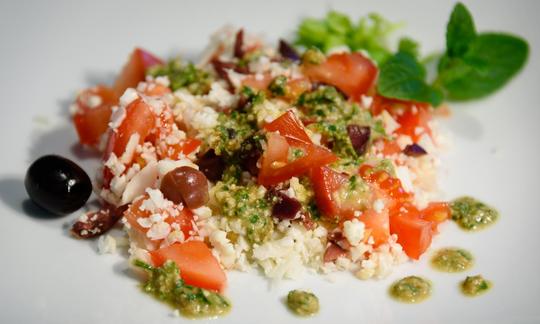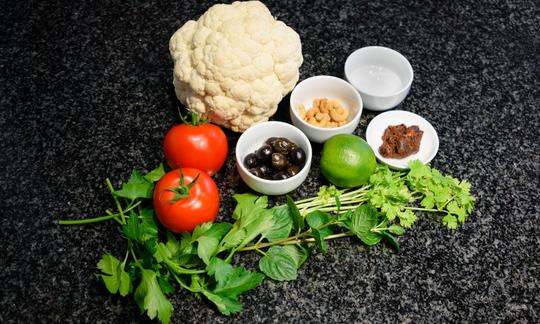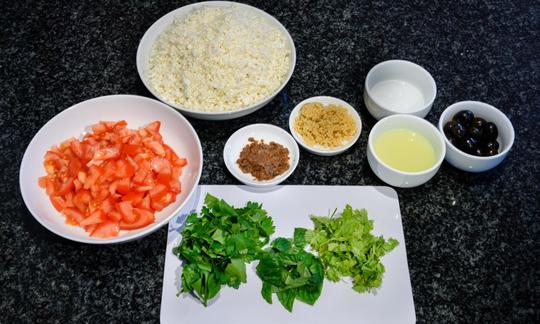Cauliflower Tabbouleh with Tomatoes, Olives and Herbs
raw-vegan
Ingredients (for servings, )
| For the Tabouleh | |
|---|---|
| 1 | Cauliflower, raw (organic?) (21 oz) |
| 5 | Tomatoes, raw (organic?) (22 oz) |
| 2 ¾ oz | Olives, black, pitted (raw?, organic?) |
| For the sauce | |
| 1 oz | Cashew nuts, raw? organic? (cashew nuts) |
| 3 | Tamarinds, raw (organic?) (0.67 oz) |
| 1 | Limes, raw (organic?) (2.4 oz) |
| 1 tsp, ground | Black pepper (organic?, raw?) (0.08 oz) |
| ½ bunch | Parsley, fresh, raw (leaf parsley, parsley) (0.53 oz) |
| ¼ bunch | Peppermint, fresh (raw, organic?) (0.18 oz) |
| 1 sprigs | Coriander leaves, raw (0.08 oz) |
| 5 tbsp | Drinking water, raw (organic?) (1.0 oz) |
Equipment
- hand-held blender / immersion blender or blender
- citrus juicer (lemon squeezer) or shredder
Type of preparation
- chop or grind
- food preparation without heating
- blend
- squeeze
Preparation
For the Tabouleh
Wash the cauliflower, break it into bite-sized pieces by hand and process it in a blender. Put the chopped cauliflower in a bowl.Cauliflower: The quantity of one cauliflower refers to a small cabbage. If you have a large one, 2/3 is enough, or you can increase the amount of the other ingredients accordingly.
Cut the tomatoes into thin strips and add them to the bowl with the chopped cauliflower along with the olives. Mix all ingredients well.
For the sauce
Place cashew nuts in a suitable container (e.g. measuring cup) and chop with a blender.Peel the tamarind, carefully separate the stones from the flesh and add the flesh to the measuring cup.
Squeeze the lime and add the juice, pepper and herbs to the cashew-tamarind mixture and process in a blender. Add the water and blend again to achieve the desired consistency.
Start with 1-2 tablespoons of tap water and add more as needed. The sauce should not be too thick, but also not drip from the spoon like water.
For garnishing and serving
Mix the tabbouleh well with the sauce and use a peppermint leaf as a garnish.
|
Nutritional Information per person
Convert per 100g
|
2000 kcal | |
|---|---|---|
| Energy | 197 kcal | 9.8% |
| Fat/Lipids | 11 g | 16.1% |
| Saturated Fats | 1.9 g | 9.5% |
| Carbohydrates (inc.dietary fiber) | 23 g | 8.5% |
| Sugars | 9.5 g | 10.6% |
| Fiber | 6.9 g | 27.6% |
| Protein/Albumin | 6.5 g | 12.9% |
| Cooking Salt (Na:61.5 mg) | 156 mg | 6.5% |
| Essential micronutrients with the highest proportions | per person | 2000 kcal | |
|---|---|---|---|
| Vit | Vitamin C (ascorbic acid) | 103 mg | 128.0% |
| Vit | Vitamin K | 57 µg | 77.0% |
| Vit | Vitamin B9, B11 (Folate, as the active form of folic acid) | 127 µg | 64.0% |
| Elem | Potassium, K | 947 mg | 47.0% |
| Min | Copper, Cu | 0.39 mg | 39.0% |
| Min | Manganese, Mn | 0.64 mg | 32.0% |
| Vit | Vitamin B6 (pyridoxine) | 0.44 mg | 32.0% |
| Prot | Tryptophan (Trp, W) | 0.07 g | 29.0% |
| Prot | Threonine (Thr, T, irreversibly transaminated) | 0.23 g | 25.0% |
| Prot | Lysine (Lys, K, irreversibly transaminated) | 0.47 g | 25.0% |
Detailed Nutritional Information per Person for this Recipe
The majority of the nutritional information comes from the USDA (US Department of Agriculture). This means that the information for natural products is often incomplete or only given within broader categories, whereas in most cases products made from these have more complete information displayed.
If we take flaxseed, for example, the important essential amino acid ALA (omega-3) is only included in an overarching category whereas for flaxseed oil ALA is listed specifically. In time, we will be able to change this, but it will require a lot of work. An “i” appears behind ingredients that have been adjusted and an explanation appears when you hover over this symbol.
For Erb Muesli, the original calculations resulted in 48 % of the daily requirement of ALA — but with the correction, we see that the muesli actually covers >100 % of the necessary recommendation for the omega-3 fatty acid ALA. Our goal is to eventually be able to compare the nutritional value of our recipes with those that are used in conventional western lifestyles.
| Essential fatty acids | per person | 2000 kcal |
|---|---|---|
| Linoleic acid; LA; 18:2 omega-6 | 1.4 g | 14.0% |
| Alpha-Linolenic acid; ALA; 18:3 omega-3 | 0.10 g | 5.0% |
| Essential amino acids | per person | 2000 kcal |
|---|---|---|
| Tryptophan (Trp, W) | 0.07 g | 29.0% |
| Threonine (Thr, T, irreversibly transaminated) | 0.23 g | 25.0% |
| Lysine (Lys, K, irreversibly transaminated) | 0.47 g | 25.0% |
| Valin (Val, V) | 0.33 g | 20.0% |
| Isoleucine (Ile, I) | 0.22 g | 18.0% |
| Leucine (Leu, L) | 0.35 g | 15.0% |
| Phenylalanine (Phe, F) | 0.24 g | 15.0% |
| Methionine (Met, M) | 0.08 g | 8.0% |
| Vitamins | per person | 2000 kcal |
|---|---|---|
| Vitamin C (ascorbic acid) | 103 mg | 128.0% |
| Vitamin K | 57 µg | 77.0% |
| Vitamin B9, B11 (Folate, as the active form of folic acid) | 127 µg | 64.0% |
| Vitamin B6 (pyridoxine) | 0.44 mg | 32.0% |
| Vitamin B7 (Biotin, ex vitamin H) | 11 µg | 22.0% |
| Vitamin B5 (Pantothenic acid) | 1.3 mg | 21.0% |
| Vitamin B1 (Thiamine) | 0.20 mg | 18.0% |
| Vitamin B3 (Niacin) | 2.1 mg | 13.0% |
| Vitamin B2 (Riboflavin) | 0.16 mg | 11.0% |
| Vitamin A, as RAE | 87 µg | 11.0% |
| Vitamin E, as a-TEs | 1.2 mg | 10.0% |
| Essential macroelements (macronutrients) | per person | 2000 kcal |
|---|---|---|
| Potassium, K | 947 mg | 47.0% |
| Phosphorus, P | 163 mg | 23.0% |
| Magnesium, Mg | 74 mg | 20.0% |
| Calcium, Ca | 87 mg | 11.0% |
| Sodium, Na | 62 mg | 8.0% |
| Essential trace elements (micronutrients) | per person | 2000 kcal |
|---|---|---|
| Copper, Cu | 0.39 mg | 39.0% |
| Manganese, Mn | 0.64 mg | 32.0% |
| Iron, Fe | 2.4 mg | 18.0% |
| Zinc, Zn | 1.2 mg | 12.0% |
| Selenium, Se | 2.5 µg | 5.0% |
| Iod, I (Jod, J) | 4.1 µg | 3.0% |
| Fluorine, F | 16 µg | < 0.1% |
Cauliflower tabbouleh is a delicious raw food combination of cauliflower, olives, tomatoes, tamarind, lime juice and fresh herbs and mint.
Cauliflower: Cauliflower, which has been cultivated in Europe since the 16th century, is considered to be one of the most easily digestible brassicas. White cauliflower is the most popular of its kind, but it is also available in orange, purple and green. It has a high vitamin C content and is also rich in B and K vitamins. However, the cooking process means that cauliflower quickly loses many of its nutrients, with around 25% being lost after just 5 minutes of cooking. In addition to eating it raw, gentler ways of preparing it include steaming.
Tamarind: The tamarind consists of over 60 percent carbon and has an antibacterial effect. The pod, which probably originates from Africa, can be divided into two groups based on taste: The sweet tamarind has a light brown flesh and, as the name implies, tastes sweet and fruity. The sour tamarind, on the other hand, has a dark flesh and a higher content of tartaric acid, which is partly responsible for the sour taste. The sweet form is better suited to this recipe and can be combined well with aromatically spicy food, such as chili or curry dishes.
Cashew nuts: At around 40 percent, the fat content of cashews is relatively low compared to other nuts. In addition, their consistency is much softer. The taste is mild and slightly sweet. Shelled cashew nuts are available all year round. They should be stored in a cool, dry place at home. Cashew nuts or cashew kernels always go through a heating process, which is necessary to deactivate the toxic oil cardol. The term "raw cashew kernels" simply indicates that the deactivation was done using steam rather than a roasting process.
Color of olives: The ripeness of the olive determines the color. The longer olives hang on the tree, the darker the color. Green olives are harvested when they are not fully ripe. Black olives, on the other hand, ripen longer on the tree and taste more intense. Due to the longer waiting time and more careful processing, black olives are usually more expensive. If you come across particularly "cheap" black olives, you should find out as much as you can about the product. Green olives are often treated with iron gluconate in order to sell them as black olives at a higher price, which is still below the average price of high-quality black olives. The taste also depends on how the olives are pickled.
Coriander: Some people react to the intense, slightly soapy aroma of coriander with aversion or even nausea. According to statistics in Switzerland, 15% of all allergy sufferers are sensitive to coriander. In these cases, simply leave out this ingredient.
Herbs: Mint gives this dish a particularly strong flavor. So don't skimp on the amount and use more rather than too little.
Amount of sauce: The amount of sauce specified in the recipe is quite small. If you like your tabbouleh a little juicier, prepare 1 ½ times the amount from the start, or use the herbs more generously as recommended above.
Using tamarind seeds: Not only the flesh, but also the seeds of the tamarind are used in the kitchen. The remaining seeds can be boiled or roasted and then processed into a puree. This goes particularly well with curries and gives dishes a spicy, tart note and a dark color.
Preserving the color of the cauliflower: If you want the cauliflower to retain its white color, you can achieve this by adding lemon juice, among other things. However, this is mainly necessary if the cauliflower is to be used as a cooked food.
Tamarind paste: Instead of fresh tamarinds, you can buy dried tamarinds pressed into a block in any Asian store (the seeds are often still included). This has the advantage that it is easy to store (once opened, it will keep in the fridge for several weeks) and is available at any time. To process, dissolve the paste and any seeds it contains with warm water to create a spreadable, workable paste.
Nuts: Instead of cashews, you can also use other nuts. Peanuts are good for increasing the protein content, while walnuts are better for increasing the omega-3 fatty acids.
Spiciness: If you like it a little spicy, chili goes perfectly with this dish - either fresh or in the form of dried chili flakes.
Citrus fruits: Instead of limes, you can also use oranges or grapefruit. However, this will give the dish a different flavor.








